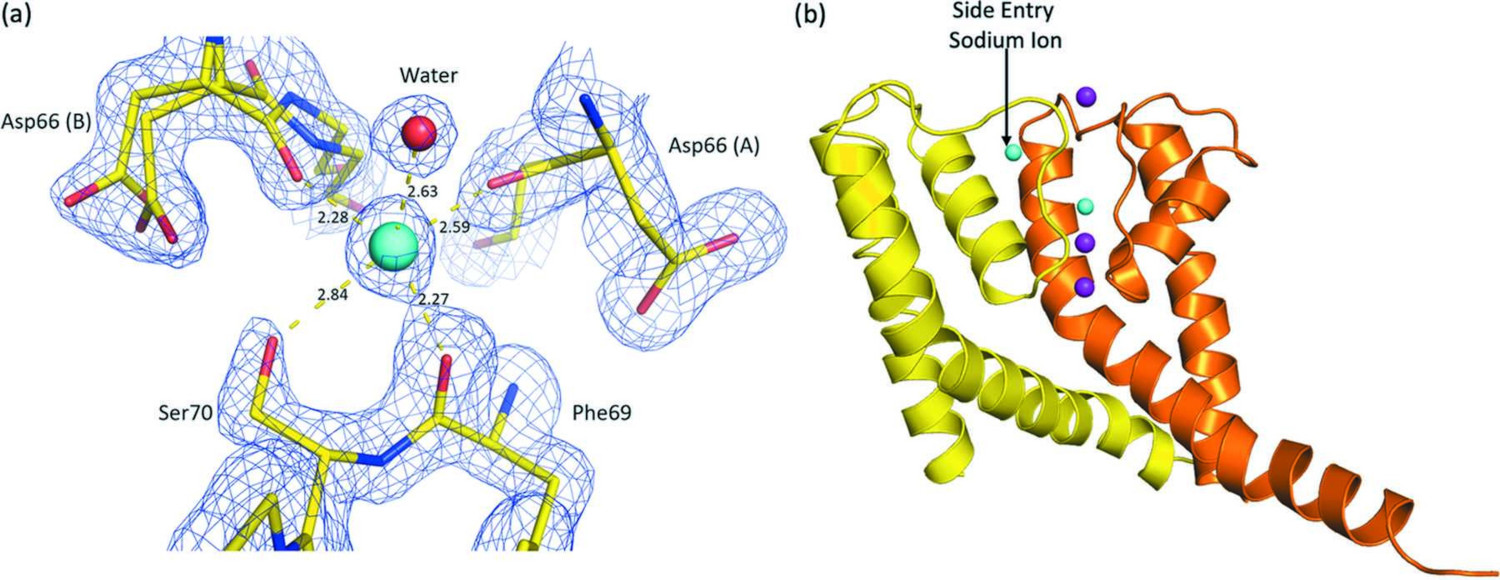Structural Plasticity of the Selectivity Filter in a Nonselective Ion Channel
05/01/2021

X-ray macromolecular crystallography reveals a potential side-entry sodium ion binding site just outside a bacterial sodium-potassium ion channel’s selectivity filter. (a) An electron density map (blue mesh, contoured at 1σ) shows the putative binding site of a sodium ion (blue sphere) formed from the backbone carbonyl oxygen atom of Asp66 (2.28 Å), the backbone carbonyl oxygen atom of Phe69 (2.27 Å), the backbone carbonyl oxygen atom of Asp66 on a symmetry-related molecule (2.59 Å), a water molecule (2.63 Å), and the side-chain hydroxyl of Ser70 (2.84 Å). (b) The position of the potential side entry sodium ion binding site in the sodium-potassium ion channel (yellow and orange, two of its polypeptide chains; blue, sodium ion; purple, potassium ion). [Reprinted under a Creative Commons Attribution 4.0 International License (https://creativecommons.org/licenses/by/4.0/) from Roy, et al. 2021. DOI: 10.1107/S205225252100213X]
The Summary
A crystallographic structure of a bacterial sodium-potassium ion channel (NaK) reveals conformational differences between the residues comprising the narrow pore within the channel, called the selectivity filter, and similar residues within selective potassium ion channels.
NaK is a nonselective, monovalent cation channel that conducts sodium and potassium ions equally efficiently across the cellular membrane even though its selectivity filter differs by only one amino acid residue from filters that selectively conduct potassium ions. Potassium and sodium ions are highly abundant in biological systems, playing key roles in the electrical activity of cells.
The crystallographic structure identifies a side-entry, ion conduction pathway for Na+ permeation that is unique to NaK. Nuclear magnetic resonance studies and molecular dynamics simulations confirmed the dynamical nature of the top part of the selectivity filter and the inner helix in NaK as also observed in the crystal structure.
Taken together, the results indicate that the structural plasticity of the selectivity filter combined with the dynamics of the inner helix of NaK are vital for the efficient conduction of different ions through the non-selective NaK ion channel.
Related Links
References
Raktim N. Roy, Kitty Hendriks, Wojciech Kopec, Saeid Abdolvand, Kevin L. Weiss, Bert L. de Groot, Adam Lange, Han Sun, Leighton Coates. “Structural plasticity of the selectivity filter in a nonselective ion channel,” IUCrJ 8 (3), 421-430 (2021). [DOI: 10.1107/S205225252100213X]
